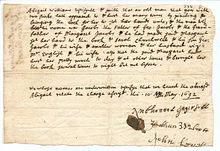Abigail Williams: Difference between revisions
No edit summary |
m →The Crucible: fixed italics |
||
| Line 8: | Line 8: | ||
==''The Crucible''== |
==''The Crucible''== |
||
Williams is one of the main characters in [[Arthur Miller]]'s play |
Williams is one of the main characters in [[Arthur Miller]]'s play ''[[The Crucible]]''. Although Miller based this play on the historical events, he took dramatic license with them. For example, ''The Crucible'' includes a wholly unhistorical amorous liaison between Abigail Williams and [[John Proctor]]. To make it more believable, Miller raised Williams' age to 17 and lowered Proctor's historical age of 60 to about 30. The playwright likewise made the fictional Williams and Proctor fairly near neighbors, although the historical people lived thirty miles apart. |
||
==References== |
==References== |
||
Revision as of 20:43, 7 May 2008

Abigail Williams was one of the original and foremost accusers in the Salem witch trials of 1692. Williams was eleven years old at the time and living with her "uncle" Samuel Parris in Salem Village (now Danvers).
After Betty Parris, the nine-year-old daughter of Samuel and a cousin of Abigail's, started acting increasingly strangely, Williams began to show similar symptoms. They threw fits, but that is obvious. According to Rev. Deodat Lawson, an eyewitness, she began to have fits in which she ran around rooms flailing her arms, ducking under chairs and trying to climb up the chimney. Some modern historians believe that these strange symptoms may have been caused on by the ingestion of a poisoned rye crop. When consumed, rye in the ergot stage of fungus development can bring on strange sensations such as burning and itching of the skin, "pins and needles" feeling, spasms, convulsions, unconsciousness, hallucinations, and psychosis. It is not unlikely that spoiled rye played a role in the events of the Salem witch trials, as rye was a staple part of the colonist’s diet. These behaviors brought attention to her, as they had with Betty Parris. A local doctor, thought to have been William Griggs, suggested bewitchment as the cause. The girls were eventually asked to name their supposed tormentors. They did so, thus bringing about the witch trials, which ended with the deaths of many innocent people. There is no definite evidence of what happened to Williams after the trials ended. One reference believes she "apparently died before the end of 1697, if not sooner, no older than seventeen." [1] Another reference (A brief historical note at the end of the Crucible, by Arthur Miller) says that "The legend has it that Abigail turned up later as a prostitute in Boston." However, given the use of the word "legend," this may very well be false. It was said that Abigail died from a common STD in that day and age according to some sources. [citation needed]
The Crucible
Williams is one of the main characters in Arthur Miller's play The Crucible. Although Miller based this play on the historical events, he took dramatic license with them. For example, The Crucible includes a wholly unhistorical amorous liaison between Abigail Williams and John Proctor. To make it more believable, Miller raised Williams' age to 17 and lowered Proctor's historical age of 60 to about 30. The playwright likewise made the fictional Williams and Proctor fairly near neighbors, although the historical people lived thirty miles apart.
References
- ^ Roach, Marilynne K. 2002. The Salem Witch Trials: a Day-to-Day Chronicle of a Community Under Siege. Cooper Square Press. Page 518.
